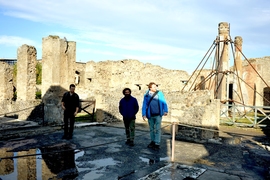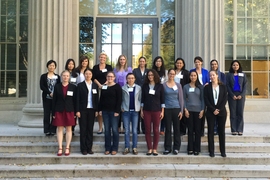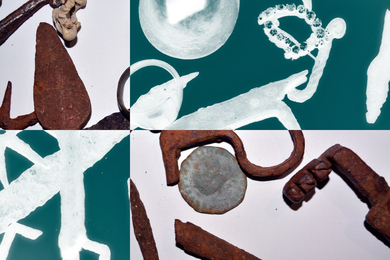Improving educational delivery is a core focus of MIT, and also a priority for training new generations of teachers in the Department of Civil and Environmental Engineering (CEE). On July 19, about 30 postdocs and graduate students attended a Workshop on Digital Education hosted by CEE to learn about digital education tools available to them as they prepare to teach undergraduate and graduate students, both at MIT and elsewhere.
The instructor, Dipa Shah of the MIT Teaching and Learning Lab (TLL), was invited by the CEE Postdoctoral Committee to provide an overview about the latest online technologies and their use for delivering content to students and providing students with practice and feedback.
Shah opened the workshop with a review of the changing landscape of university education in the United States and a snapshot of ways MIT is using digital learning. She noted the Institute’s residential MITx online learning platform — which allows faculty to author interactive text, post videos, create virtual "labs," and assess student learning — has been used by over 90 MIT faculty and 80 percent of undergraduates. “Some MIT professors are moving content to the MITx platform so they can flip the classroom — asking students to review material prior to class and then using in-class time for practice,” said Shah. “This allows students to assess where they are, engage with their peers, and engage with the faculty.”
"After my postdoc, I will be looking for a faculty position,” said Sarah Safieddine, a workshop participant, “Having insights on the state-of-the art digital technology techniques for teaching will help me write a better teaching statement, as well as use these techniques in my future classes."
Through the CEE's Postdoctoral Teaching Fellowship program, postdocs have the opportunity to gain experience in classroom and laboratory teaching, and can apply some of the techniques presented at the workshop, further strengthening their professional profiles.
Training future faculty
Shah encouraged participants to examine how technology can be leveraged to support student learning. Workshop participants used their laptops and smartphones to interact with some of the software tools she highlighted. She also walked them through case studies of ways in which faculty across MIT already are using digital platforms today in their courses.
“Even as a senior graduate student, I didn’t realize there are such rich online education resources at MIT that I can use to enhance my learning until I attended this workshop,” said Kai Pan, PhD candidate in CEE and computational science engineering. “I think digital education is certainly the future direction of educating students, or at least will be served as an important supplement to the traditional approach of education. If I were becoming professor someday, I would definitely develop the digital education materials for my class.”
The use of smartphones, tablets, and laptops in the classroom is growing, Shah said, adding that surveys show many students own all three types of devices. “Students ask instructors to use more tech in the classroom, but then students sometimes get distracted using it, or watching their peers using it, so you’ll need to evaluate if, when and where to add technology.”
Blended learning scores high marks
Shah continued, “Consider using a combination of traditional in-class teaching methods with digital applications,” citing recent studies that indicate blended approaches work well. “Digital tools used in or out of the classroom can significantly enhance the learning experience by helping faculty use class time for interactions that matter most, capturing students’ attention, and assessing their progress towards subject outcomes.”
She also spoke about the types of instructional practices that help students learn, again stressing a combination of approaches. For example, using quizzes to promote knowledge retrieval, spacing practice of a given concept over time, asking students deep explanatory questions, combining graphics with verbal descriptions, and connecting abstract and concrete representations of concepts have all proved effective and complementary.
“There are hundreds of interactive applications available for teaching, enhancing collaboration and facilitating dynamic interaction,” she added, “Try some and see which work for your context.”
Konrad Krakowiak, a postdoc working with Professor Franz-Josef Ulm, said he assisted in teaching his first lab subject, 1.035 (Multiscale Characterization of Materials), this past term using basic desktop presentation software as a teaching tool. “I see a lot of opportunities for exploring advanced technology to enhance teaching and learning,” he said. “For example, I like the idea of giving online quizzes and tracking responses globally, and on an individual basis, to monitor students’ progress. It would be great to see at a glance the percentage of the class, and the students, that understand or don’t understand the material. That way, I can move the class along more effectively and 20 students don’t show up during office hours with the exact same question to whom I have to repeat the exact same answer.”
At the same time, Krakowiak — who won a CEE Postdoctoral Scholar Mentoring, Teaching, and Excellence Award this May — admitted he is hesitant to adopt technology that may not be fully ready for implementation and use. “You need to put some work up front to make sure that the system works 100 percent when you want to use it. You don’t want to have to take time from class to troubleshoot networking or other problems,” he said.
Shah couldn’t agree more, and that’s why she concluded the workshop by reviewing a framework for selecting and using technology. Other indirect factors — such as Wi-Fi availability and accessibility, ease of use, students’ security and privacy concerns, and cost — should be considered too, she said, when selecting technology-based teaching options. In addition, Shah cautioned workshop attendees that satisfaction with an app or program is not the same thing as learning effectiveness, so full analyses of results should always be part of the evaluation process.
Virtual reality?
New educational technologies are especially important for those involved in fieldwork, new types of hands-on subjects, or training in design. For instance, Assistant Professor Admir Masic recently led a student group summer field trip to Italy with unprecedented access to ancient art, archeology, and architecture.
“I can’t just lecture at a blackboard and expect the students to remember, understand, and appreciate the wealth of knowledge, beauty, and complexities we uncovered during our fieldwork,” he said, referring to the summer program’s follow-on subject, 1.S993 (Heritage Science and Technology), that he is teaching this fall. “I need to document the things we saw using video, annotations, and interactive software, including making 3-D reconstructed models. I want to remind the students where they stood, how structures were designed and fit into their surroundings, and what contributed to their resiliency over centuries.”
Videos taken in the field, for example, can be edited and integrated with other content and instructor’s comments to significantly enhance subsequent classroom and lab exercises. “This is exactly what I need to ensure the longevity of my teaching material and promote greater interest and interactivity with the students,” said Masic.
“It is exciting to hear about all the new tools available for digital education,” said Professor John Williams, chair of CEE’s Postdoctoral Committee, and also CEE’s Committee on Digital Education, who helped organize the workshop. “We plan to introduce some of the tools mentioned in the workshop in CEE’s new collaboration with the MIT Office of Digital Learning and use some of its MITx facilities in our courses.”









